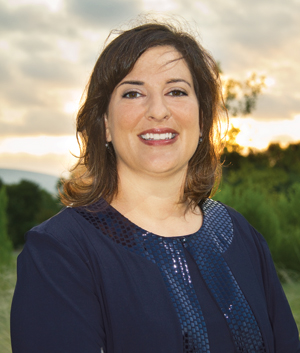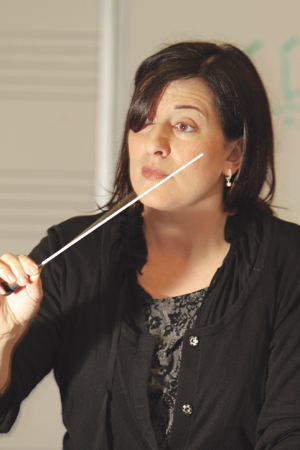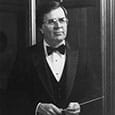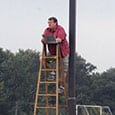 What expectations do you set for students, and how do you help them reach these?
What expectations do you set for students, and how do you help them reach these?
When I first drop the baton, no matter what level, I want students to read confidently with characteristic sound. The thing we stress is that notes, rhythms, and articulations aren’t really music making, that’s just the mechanics, and none of that will matter unless they make a good sound, so the first thing students should strive for is a characteristic sound, then intonation, balance, and blend.
We use synthesized drones for tuning exercises. We start out with unisons moving around the circle of fourths, and students have to be able to hold the unison. Then we’ll break it into fifths, with woodwinds on concert Bb, and brass on concert F, and go around the circle again to help them learn how that sounds. After students can tune intervals well we advance to major, minor, and dominant seventh chords.
The long tones build endurance and provide a chance for students to hear themselves in all keys and with all voicings because not every chord they come across will be in root position. When we play long chords, we adjust the voicing so no student is always the root. Once students can hold a straight tone we play exercises where they crescendo or diminuendo. The ability to control pitch and tone while making a change in dynamics makes students stronger players.
How do you teach students to be comfortable in all keys?
.jpg) I like to do exercises around the circle of fourths. We start going around the circle of fourths with the younger ones coming into the program. Students learn to transpose with simple patterns such as arpeggios and five-note runs. We pick a pattern and play it around the circle of fourths. Eventually we open the range of notes up to a full octave. I want students to be accustomed to playing in E or B; this way nothing seems too exotic.
I like to do exercises around the circle of fourths. We start going around the circle of fourths with the younger ones coming into the program. Students learn to transpose with simple patterns such as arpeggios and five-note runs. We pick a pattern and play it around the circle of fourths. Eventually we open the range of notes up to a full octave. I want students to be accustomed to playing in E or B; this way nothing seems too exotic.
I point out arpeggios and scale patterns in the music so students understand why we spend so much time on technical studies and scales. It’s similar to learning to read and having to sound out long words like asparagus. Children eventually get to the point at which they can just see the word and know it without having to sound it out. The same is true with music, and I want students to build that memory to the point that they can see an E major scale or arpeggio and not have to think about fingerings.
How do you teach intonation?
We do quite a bit of sight singing and teach students solfège. We sing scale patterns and will also sing through chorales. I tell students that I want them to hear the music in their heads and compare what’s coming out of their horns to how the music is supposed to sound. That way they know if they’re playing it correctly. I tell students that I want them not to need me anymore. They should know if a rhythm or pitch is wrong or if they’re out of tune. Sometimes the younger students lack the physical ability to make the change, but at least they know when there is a problem and are trying to adjust.
As a trumpet player, I always thought intonation was more important for brass players, but woodwinds need to learn to play in the center of the pitch, too. We spent extended time earlier in the year working on scales and intervallic relationships, which can be horribly out of tune. At first that’s a weird concept to students, and when I comment that someone is out of tune, the response is frequently, “But Miss Keller, I’m not playing with anybody.” I think the sight singing helps them learn that they need to play in tune when playing alone.
One warm-up favorite is a chorale book called Bach and Before for Band; it has 19 chorales with soprano, alto, tenor, and bass parts for each instrument. I tell students to pick a voice, and after playing through a chorale, everybody moves down a voice, so the sopranos now play alto. Working through each part forces students to listen carefully. During the first part of the year I have students count off by fours as soprano, alto, tenor, and bass. Students know that they will eventually play every part, so there is almost never an abundance of one voice. The variety prevents students from losing focus as they might with the same warm-up every day.
How do you work around a block schedule?
We have A and B days consisting of four 90-minute classes each. Although not all students can schedule it, we encourage students to take band on both days. In the fall we focus on the marching music on A days and rehearse all-region and concert music on B days. If we have an upcoming contest and something’s not working well, we practice the marching music on B days. During marching season most of our sightreading is pep tunes, and we go through a lot of them. We might spend a day or two a week reading new concert band pieces.
In the fall semester the percussionists have percussion class on A day and percussion ensemble on B day. These work just like the wind classes: marching percussion practice on A days in the fall, and B days are for all-region or percussion ensemble music. In the spring semester percussionists are in the band classes but still have the percussion ensemble on B days.
After marching season and before the winter concert, we usually squeeze in three weeks of sectionals. Weekly sectionals start in mid to late January, when the second semester officially starts. Every section has a sectional once a week before or after school.
How do you approach chamber music?
Everyone in the first two bands, wind ensemble and symphonic band, is required to play a solo, and we encourage additional ensembles. The solos and etudes that students play are going to be more difficult than what they play in full band. It requires different skills. Band music is difficult for different reasons, and for students to develop completely as musicians they have to work on both elements. Students in the concert band are not required to go to the contest, but they are assigned etudes and solos as well.
How do you audition students for placement in a concert band?
 Auditions consist of an etude or solo of choice and an etude that is required for everyone, and all 12 major and minor scales. If a section is especially strong, we might pick a more difficult etude to make it easier to delineate students. Almost all students in the first and second bands study privately, with a smaller percentage in the third band. We get some University of North Texas students to teach, but the teachers who have been with us the longest are professionals who teach and play in the area. We have a formal indoor concert in December and another one in February. Then we start on our University Interscholastic League music for April, and give one more concert in May.
Auditions consist of an etude or solo of choice and an etude that is required for everyone, and all 12 major and minor scales. If a section is especially strong, we might pick a more difficult etude to make it easier to delineate students. Almost all students in the first and second bands study privately, with a smaller percentage in the third band. We get some University of North Texas students to teach, but the teachers who have been with us the longest are professionals who teach and play in the area. We have a formal indoor concert in December and another one in February. Then we start on our University Interscholastic League music for April, and give one more concert in May.
What is most difficult in teaching students to play well?
The most difficult part is getting students to make musical decisions. We work on that when playing scales and chorales; I don’t always tell them “crescendo here and diminuendo here.” I ask students, “What do you think we should do with this fermata?” or “Should we make this release taper, or crescendo it to the end?” It makes it more interesting if they can have input over such things. There might be one way to play something that is preferable, but students don’t usually make poor musical decisions. There are so many talented band students in and around our region, and many of them will be able to play the notes and rhythms flawlessly. I get students to think about how to make their performance stand out.
When students make musical choices, the first reason they give is that they like the way it sounds. Older students might say something like, “This is the end of this phrase, and we should use the pickup notes to crescendo into the new section.” This year the audition etudes had few dynamic or expressive markings, so in almost every session with a student I asked what they were going to do to make it sound interesting.
.jpg) What was it like opening a new high school?
What was it like opening a new high school?
I have been at Liberty High School since it opened in 2006. The first year we opened with just 9th and 10th graders – a total of 38 students in band. We were housed at Fowler Middle School, which now feeds us, until our high school building could be built. At first there was some controversy when Liberty opened, because parents were worried their children were not going to have a true high school experience between the small student population and meeting at a middle school, but it actually turned out to be a wonderful year. Because we were small everybody grew close together, and it was fun to be able to establish traditions, including gong shows twice a year, one after marching season and one on our spring trip. This laid a good foundation for our start.
In the first year we felt that we needed some kind of spirit cheer. The drum majors will yell “R” and the students yell “respect,” “E” “excellence,” “D” “dedication,” “H” “honor,” “A” “achievement,” “W” “willpower,” “K” “knowledge,” “S” “success.” That little acronym is the way we dismiss from the marching field.
We also started a march-a-thon, which is one of our biggest fundraisers. Usually we’ve been practicing a week or two, and then we march in neighborhoods that feed Liberty High School. Having a mini-parade in the neighborhoods gets some of the younger students excited about band. We usually march just under three miles. When we’re walking along the way people come out. I think the rule is we can’t go up to them and solicit, but people come out of their houses and give us donations to play in front of their house and might request “Happy Birthday” for a family member.
I also instituted social networking rules for students, something that first became necessary when I was the assistant director at Frisco High School, right around when Facebook and MySpace were starting to become popular. Rumors and insults can spread quickly, so I encourage students to talk directly with anyone they have a problem with rather than air grievances for everyone to see. Trust is extremely important in the band program because there are so many students and only four of us. We cannot watch every person every second, and if we go on trips we have to trust that students can behave and represent the band program and school well.
 We also instituted a rule that only band students may be in the band hall. These students work so hard and there’s so much expensive equipment in here that the directors simply can’t protect the band students and equipment all the time. I also like students to feel that they have a place of their own. We spend so many hours here that it’s like a home, and I like to know who’s coming into my house. The students enforce it. If they see somebody who is not a band student they give him the evil eye. They just know that it’s the rule. No one is mean about it, but they’ll say, “Hey, I need you to wait for your friend outside.”
We also instituted a rule that only band students may be in the band hall. These students work so hard and there’s so much expensive equipment in here that the directors simply can’t protect the band students and equipment all the time. I also like students to feel that they have a place of their own. We spend so many hours here that it’s like a home, and I like to know who’s coming into my house. The students enforce it. If they see somebody who is not a band student they give him the evil eye. They just know that it’s the rule. No one is mean about it, but they’ll say, “Hey, I need you to wait for your friend outside.”
In the first year I occasionally assigned research on a piece and the composer. Many students got into the habit of seeking out the music online and downloading recordings. We also started a tradition of mentioning area concerts, and having the University of North Texas, the Dallas Wind Symphony, and the Dallas Symphony Orchestra nearby provides many opportunities to go to events and discuss them the next day.
In our first year we didn’t have any all-state students, then the next year we had one, then six, and this year ten. Between that and the Midwest trip, it’s an exciting time at Liberty High School.
All photos for this article were taken by Dave Shaver.





